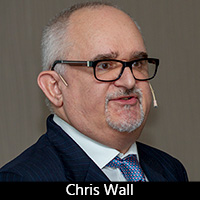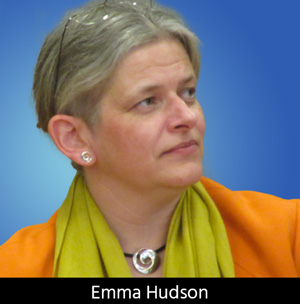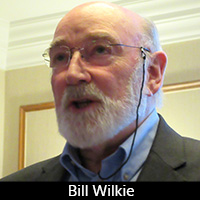Journal CSS
|
|
Institute of Circuit Technology Technical Webinar19th November 2020
Pete Starkey |
|
|
With its regular programme of physical seminars and symposia on hold, the Institute of Circuit Technology went virtual this year and presented a webinar of three technical papers, organised by Technical Director Bill Wilkie and introduced by IPC Chair Emma Hudson. Dr. Dave Shaw from A-Gas Electronic Materials introduced an innovative transparent PCB material. The market for transparent conductive films was currently dominated by indium tin oxide (ITO) for both glass and flexible substrates. The main limitations of ITO were its brittleness and the cost of imaging. Its dominance was likely to continue on glass, but it would probably be displaced on flexible substrates by materials with better flexibility, formability, and transparency, imageable by lower-cost alternatives to laser ablation. The current materials choice was poly(3,4-ethylenedioxythiophene) (PEDOT), silver nanowires, and metal mesh. Carbon nanotube technology offered newer alternatives, and Dr. Shaw discussed a hybrid ink-based on carbon nanotubes and silver nanowires, which offered technical and functional benefits. On a cost comparison with ITO, although the material itself was more expensive, once imaging was taken into account, substantial savings could be realised. Regarding fabrication and processing requirements, existing PCB and printed electronics shops had all the basic facilities. Two imaging routes were demonstrated: direct imaging by screen printing and curing, or print-and-etch on film pre-coated with silver nanowires, using the carbon nanotube ink as a resist that remained in place as a functional part of the end product and therefore did not need stripping. Only a mild ferric nitrate etchant was required. The result was excellent flexibility, high transparency, and very low electrical resistance. Alternatively, the carbon nanotube ink could be screen printed as an etch resist onto a copper metal-mesh film then etched to produce a patterned transparent conductive film. Dr. Shaw showed several examples of transparent flexible circuits, as well as transparent antennae for 5G, transparent touch sensors, transparent lighting films, and transparent heaters for automotive applications. Numerous additional opportunities for growth and application diversification were being explored. |
 |
Dr. Jonathan Swanston, CTO of Jiva Materials, gave an update on the U.K. government-funded ReCollect project for the efficient manufacturing of recyclable composite laminates for electrical goods. Through its Inquiry Into Electronic Waste and the Circular Economy, the government’s Environmental Audit Committee was exploring how the U.K. could reduce its environmental impact, create economic opportunities, and maintain access to critical materials by better managing and minimising its e-waste. The ReCollect Project aimed to reduce the impact of the e-waste stream using naturally derived products. Jiva was the inventor of Soluboard—a patented, competitively priced, and fully recyclable printed circuit board substrate—and was leading the specification and development of the thermoplastic input materials as well as the conversion of the substrates into working circuit boards. The unique attribute of Soluboard was that it dissolved in hot water, yielding biodegradable and non-toxic products. Components were recoverable and recyclable. A Soluboard circuit was claimed to have 60% lower carbon footprint than a standard PCB. Jiva was targeting 5% of the market sector for single and double-sided boards in household appliances by 2027. Testing and preparation of the material safety datasheet were proceeding, and guidelines for additive and subtractive processing were being developed. Electrical properties were comparable with FR-4 and CEM1, thermal conductivity was similar to FR-4, mechanical properties similar to CEM1, and flame retardancy in line with UL94V0. |
 |
Chris Wall, technical director of Electra Polymers, gave a detailed overview of the state-of-the-art in inkjet solder mask. He categorised the different types of solder mask by patterning method: liquid photoimageable, whether by contact printing or LDI, he classified as indirect; and screen printing and inkjet printing he classified as direct, meaning that the pattern was placed directly where it was needed, rather than being coated, then imaged and developed. Inkjet techniques were categorised as continuous or drop-on-demand—the type used for solder mask application, and drop-on-demand was further categorised by print-head type; thermal or piezoelectric—the principle generally used. Good print performance of a particular ink depended on collaboration between the ink and equipment suppliers. A wide range of proven equipment was currently available, and ink formulation was becoming a mature technology. Inkjet solder mask offered several advantages: there was no artwork—the image was created directly from the CAM data, so it was repeatable and capable of being dimensionally optimised to compensate for distortion of the circuit image. The material was effectively 100% solids, so there was no solvent emission, the fully-additive process meant there was no material wastage, and the process had the potential for high throughput as well as a significant reduction in process steps compared with the liquid photoimageable process. Wall discussed, in general terms, the different types of print-heads and how they influenced the properties of the drops they generated before delving into the physics of stable drop formation in terms of drop velocity, ink density, nozzle diameter, ink viscosity, surface tension, and the relationships between them. He demonstrated the mathematical derivation of Reynolds number, Weber number, Ohnesorge number, and the Fromm Z parameter. By plotting Ohnesorge number against Reynolds number, he showed how the optimum characteristics of a printable ink could be predicted. Clearly, ink formulation involved more than trial-and-error mixing of cans of green paint! Once the perfect droplets had been generated and directed to the required location on the circuit board, there was a further set of considerations to take into account: wetting and controlled flow, followed by fixing in position. Print-strategy optimisation involved specialised surface treatments to minimise droplet spread, different print-profile recipes to suit different board designs, and pin-curing to fix the droplets in place. After printing, there was typically a high-intensity UV cure, followed by a final thermal cure. In the context of wetting and spreading, Wall discussed the physics of contact angles and the effect of substrate surface treatments and showed cross-sections of solder dams between component pads. Multi-layered print profiles could be used to create dams around pads and prevent thinning on track edges, and to build thickness selectively. Electra’s proprietary inkjet solder masks qualified to IPC-SM-840E Class H and T, and UL94V-0, and had been proven to endure severe thermal storage and thermal shock testing. |
 |
Emma Hudson moderated a lively question and answer session before bringing the webinar to a close and thanking presenters for their contributions, delegates for their attention, and especially Bill Wilkie for his expert organisation of an excellent event. Pete Starkey I-Connect007 |


